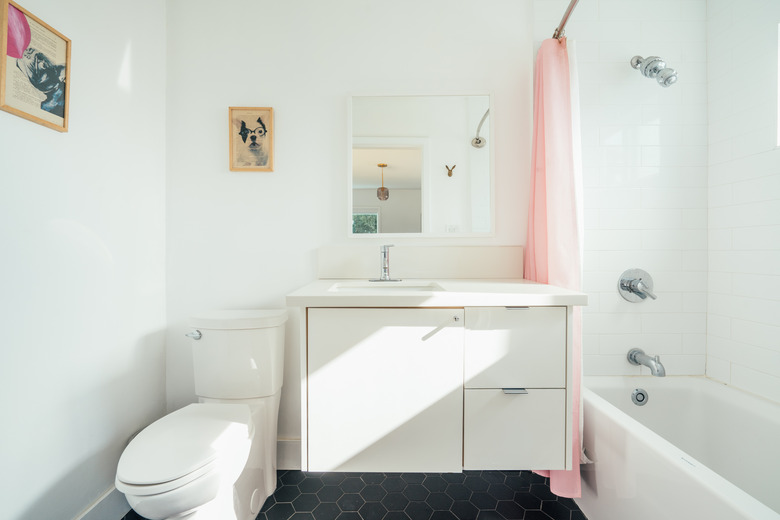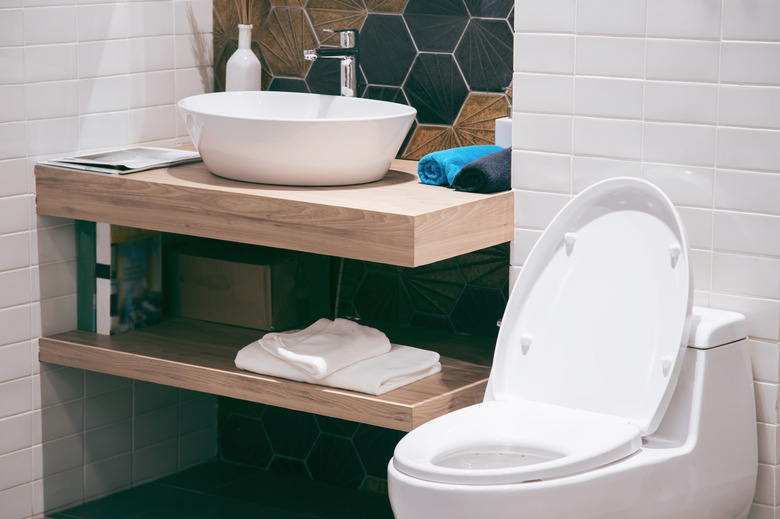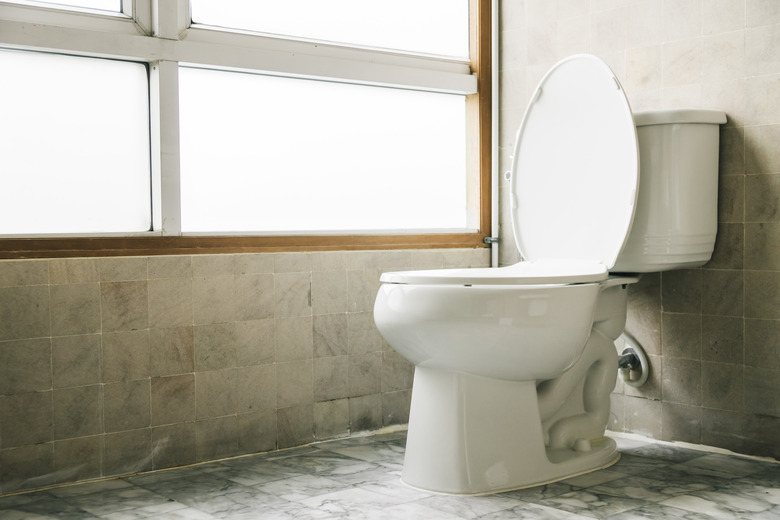Best Ways To Unclog A Toilet And Prevent Overflow
We may receive a commission on purchases made from links.
When you have a clogged toilet, the first thing you should do is reach for the plunger. Every plumber would agree with that, although, as Fast Plumbers points out, it has to be the right kind of plunger because the one you use to unclog your sink won't work in the toilet. Plunging works most of the time, but when it doesn't, you need a plan B and possibly plans C, D and E as well because the obstruction causing your clogged toilet could be anywhere in the toilet or the toilet waste line. It could even be in the main sewer and affecting other drains as well as the toilet.
If the toilet is filled to the brim, inserting a plunger and pumping it is going to spill wastewater onto the floor, so your first order of business is to stop the bowl from filling. Once you've done that, you'll have time to run through a series of procedures, one of which will hopefully break the clog and get the water to drain.
Start By Turning Off the Water
Start By Turning Off the Water
As soon as you realize the water isn't draining, refrain from flushing. If the toilet is in the middle of a flush, you can take quick action to try to prevent an overflow. Remove the tank lid and push down the flapper (the round rubber flap at the bottom of the tank) to stop the flood of water from the tank to the bowl. Next, turn off the toilet water supply shutoff valve, which should be on the wall behind the toilet on the left side (turn it all the way clockwise). This stops the toilet's fill valve from refilling the bowl.
Depending on how quickly you do this, a certain amount of water will remain in the tank, and that will end up on the floor if you flush again, so don't flush. If the toilet is filled to the brim, transfer some of the water to a bucket. You can use a siphon pump to do this, but if you don't have one, a turkey baster will do. Just make sure you decommission the baster for other jobs around the house, especially basting turkeys. It's now a dedicated bathroom tool.
Diagnose the Toilet Clog
Diagnose the Toilet Clog
A blockage in the toilet trapway (which is likely if someone flushed something that shouldn't be flushed, such as a diaper or a plastic toy) will cause an immediate backup and the bowl will fill quickly. The trapway is sinewy and narrow, as illustrated by Korky, and it's easy for objects to get lodged there. A clog further along in the waste pipe caused by a buildup of sediment will reveal itself more gradually, and you'll probably notice sluggish flushing before the actual stoppage occurs.
If the obstruction is caused by a buildup in the waste pipe, there's a good chance that the water level in the toilet bowl will drop gradually when given enough time. If that happens, you might be able to help things along by pouring hot water into the bowl. A clog in the toilet trapway, on the other hand, is best removed by mechanical means.
Plan A: Clear Your Clogged Toilet With a Plunger
Plan A: Clear Your Clogged Toilet With a Plunger
A toilet plunger, unlike a sink plunger, has a narrow opening that fits inside the waste opening in the bowl to make a good seal, and it has a bell or bellows behind it that can develop considerable force — even enough to dislodge a diaper — if you use it correctly. Tilt the plunger when you immerse it in the bowl to allow the bell or bellows to fill with water. That way, you won't be pumping air, which is a compressible gas, but rather water, which is an incompressible fluid.
Pump vigorously several times and then remove the plunger to see if water starts draining. If you don't notice any progress after a few repetitions, check the shower and bathtub drain to see if water has been spurting out. This can only happen if the obstruction is in the waste pipe and not the toilet itself, so dry drains are a sign to move on to plan B. If you see signs of water, cover all the drains in the bathroom with duct tape to focus the force of the plunger on the obstruction and keep pumping until you're sure it's not going to work.
Plan B: Put on Gloves and Reach Right In
Plan B: Put on Gloves and Reach Right In
Ask the Builder advises that most toilet clogs are in the toilet itself, owing to the narrow passageways formed by the toilet trapway. The waste line beyond is wider and can easily accommodate anything that passes through the toilet. If the other bathroom drains are dry, and plunging didn't dislodge the obstruction, the next DIY tool at your disposal is a pair of water-resistant protective gloves that cover your forearms because you may be able to pull out the object.
Before you do this, you'll want to empty more of the water from the toilet bowl into a bucket. Set the contaminated water aside to be poured back into the toilet when the clog is gone. Put on the gloves and reach into the bowl opening as far as you can, and if the obstruction is something like a diaper or a wad of toilet paper, you may be able to grab a corner of it and pull it out. You probably won't be able to reach it if it's lodged near the top of the curve formed by the trapway, though, and in that case, it's time to move on to plan C.
Plan C: Use an Excavating Tool
Plan C: Use an Excavating Tool
An excavating tool that will fit inside a toilet trapway must be thin and flexible while still being strong enough to do some damage — to the obstruction, not the toilet. A straightened-out wire coat hanger might do the job, as might a long piece of 12- or 10-gauge electrical cable, but the actual tool designed for the job is known as a toilet auger, or drain snake. Beware because not all drain snakes are the same, and one designed to clear a sink won't pack enough punch for a toilet, while a plumbing auger designed to clear a sewer will damage a toilet.
A toilet auger is typically 3 feet long, which is long enough to reach all the way through the trapway. Insert it into the bowl opening and push, maneuvering as necessary to get the head through all the curves of the trapway until it won't go any farther. Crank the handle and hopefully the head will chew its way through the obstruction or latch onto it, and when you pull out the auger, the debris should come with it. It's possible the auger will push the obstruction farther into the toilet, but that's usually a good thing because when it reaches the waste opening, it should move down the drain.
Plan D: Pull the Toilet
Plan D: Pull the Toilet
Objects can lodge in the rear portion of the trapway beyond the high point or even at the entrance to the waste pipe, and if an object is too hard for an auger to latch onto, you won't be able to retrieve it. However, if you remove the toilet and turn it over, you can pull it out easily. If it comes to this, purchase a new wax ring before removing the toilet because you'll have to replace the old one.
You'll want to empty the toilet bowl as thoroughly as possible using a siphon pump or a turkey baster in conjunction with a sponge to avoid getting water on the floor. Toilets are heavy, so you may need a helper to assist you, and when you get the toilet off, you'll probably see the obstruction immediately either inside the toilet or in the waste opening. Put those gloves back on because it won't be pretty.
In the event that you don't find the obstruction, it must be in the waste line, and there's a good chance that it's close enough to the inlet to reach with a toilet auger. Give the auger a try and if you aren't successful, it's on to plan E.
Plan E: Find the Cleanouts
Plan E: Find the Cleanouts
Most toilet waste pipes have at least one code-mandated cleanout, which is a sanitary tee fitting with a screw-on cap. If you don't see one in the bathroom, there's probably one at the point where the waste stack empties into the sewer, which is usually in the basement or crawl space. You'll need a pipe wrench to unscrew the cap, and once it's off, you'll know which direction to insert your auger. If water comes spilling out when you open the cap, the obstruction is downstream, and if no water comes out, it's upstream. In any case, be prepared for wastewater coming out of the cleanout, sometimes with force.
Feed a toilet auger or a sewer auger (which is longer) in the direction of the obstruction and crank vigorously when you contact it. Be careful if the obstruction is upstream because as soon as you break through, contaminated water will come spilling out of the cleanout opening.
What About Using Chemicals?
What About Using Chemicals?
You might think you could have saved yourself a lot of trouble by just pouring Drano in the toilet to unclog it, but even S.C. Johnson, the manufacturer of Drano, will tell you that's a bad idea. The only Drano product recommended for toilets is Drano Max Build-Up Remover, and it's a slow-acting, enzyme-based drain cleaner that won't help in an emergency.
Other Drano products, as well as most drain cleaners from other manufacturers, contain either sodium hydroxide or sulfuric acid, and you don't want either of these chemicals in your drain pipes. When reacting with sludge that causes clogs, these drain cleaners generate enough heat to damage the pipes, and since they can't move through the pipes freely, they collect in the toilet bowl and could actually cause skin burns. Besides, if the water isn't flowing, how is a drain cleaner going to get to the clog in the first place?
If you want to try some kind of drain cleaner, try pouring a cup of baking soda in the toilet followed by a few cups of vinegar, as recommended by Liquid-Plumr. The chemical reaction produces a cleansing fizz that may make it to the sludge in the pipe and dislodge it, and although the fizz may spill onto the bathroom floor, it won't do any damage. Similarly, a mixture of dish soap and hot water may lubricate the obstruction enough to dislodge it.
When to Call a Plumber
When to Call a Plumber
If you can't find the obstruction and other drains in the house are running slowly or are stopped, you probably have an clog in the sewer, and that could be caused by tree roots, a broken pipe or something else beyond the ability of a DIY homeowner to address. You can sometimes clear out roots with a sewer auger, but as Roto-Rooter explains, you might not get all of them, and the problem will just recur.
It takes an experienced pro using a camera and other specialized technology to do a complete root removal procedure, and you'll also need a pro if the problem happens to be a break in the sewer. These are major plumbing problems, but the good news is that you can usually see them coming long before the toilets clog, and you have plenty of time to address them before an emergency occurs.


